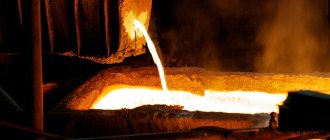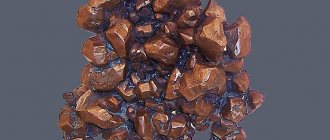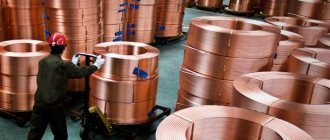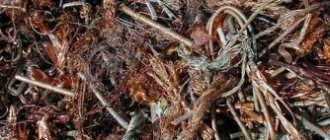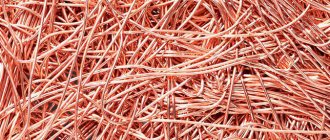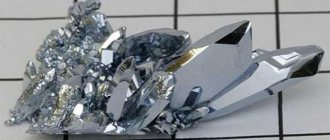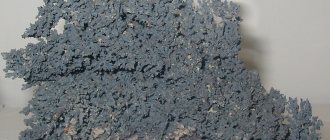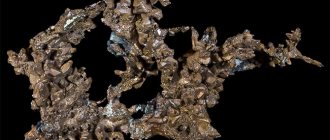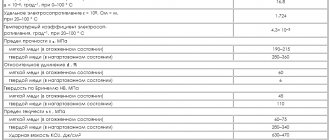Chuquicamata. Chile
One of the world's oldest and largest copper deposits, copper mining began in 1915, and the quarry is located at an altitude of 2,840 m in the Central Andes.
In terms of the volume of ore mined, it lost the palm to Escondida, but in terms of size it remains one of the largest. The quarry is 4.3 km long and 3 km wide. Moreover, work is already underway at a depth of over 850 m.
At the turn of the 60-70s of the last century, the Chilean industry began to develop ore. It should be noted that the company’s employees conduct not only production, but also active exploration to find new deposits.
2
Applications of copper ore
The metal is in demand in metallurgy, where it is used to produce alloys and various products. Alloys are made from ore:
- bronze;
- brass;
- cupronickel;
- constantan, etc.
Copper tools do not create a spark, so they are used wherever there is a danger of explosion.
Metal is used by industries of specialization:
- Mechanical engineering. They produce parts for cars (bearings, window lifters, etc.).
- Electrical engineering and energy. They produce power cables and wires.
- Shipbuilding. The hulls and structures of ships are sheathed with metal.
- Jewelry making. Increases the strength of jewelry metals.
- Construction. They manufacture plumbing equipment and roofing.
In pharmaceuticals, metal is used as an astringent and antiseptic. The chemical element is one of the components of eye drops, solutions for burns, vaccinations, etc.
Escondida. Chile
On the northern edge of the Atacama Desert in the second half of the 20th century, large deposits of copper ores were discovered at an altitude of more than 3 thousand m above sea level.
Over the course of several years, a project was developed, and in 1990, open-pit copper mining began in this part of Chile. By 2011, this quarry had become the largest of all the world's deposits.
2007 was a record year, when 1.5 million copper was extracted from the bowels of the earth. The deposit consists of two huge quarries, and in total over 6,000 people are employed in the extraction and transportation of valuable metal.
3
What ores do copper come from?
The metal is found both in compounds and in native form.
The largest nugget found in the USA. Its weight was more than 420 tons.
There are a total of 20 types of ores from which copper is extracted. The most commonly caught species are:
- Chalcopyrite. Contains 36.4% copper, 34.9% sulfur, 30.56% iron. Sometimes the composition may include traces of gold and silver. Crystal structure. The ore has a pronounced yellow tint. Over time it fades.
- Chalcocine. Composition: 80% copper, 20% sulfur. Has a metallic luster. The structure is granular and dense. Color varies from lead gray to black.
- Bornite. Contains copper, iron, sulfur, silver. The percentage of substances is not constant. The crystal structure is complicated cubic. There are filled tetrahedral structures. The color is bronze-yellow, copper-red with blue, purple or reddish tints.
Bingham Canyon. USA
A giant deposit, where open-pit copper mining has been carried out since 1863. This is the deepest copper quarry, with a depth of 1,200 m.
The size of the anthropogenic formation is truly amazing. It covers an area of 7.7 km² and is 4 km wide. According to geologists, ores containing copper will last for many decades, because reserves are estimated at 640 million tons.
Every day, 450 thousand tons of rock are extracted to the surface, and 1,400 workers work on the extraction. In 2013, a landslide occurred in the quarry, stopping work for several months.
4
Global copper market: leading countries in production and extraction
Copper is the very first existing metal that became known to man. Over the centuries, it has become very deeply embedded in our everyday life. Today, however, copper is not as common, ranking third behind more well-known and widely used minerals such as aluminum and iron. Under natural conditions, this metal is not in its original state; it is obtained by mining ores of different compositions. The suitability of ore for beneficiation is determined if it contains 0.5-1% copper.
The types of copper ore found in a porphyry copper mine depend on the location and rock stock:
- The stratiform type includes sandstone and copper shale;
- A unique type of copper nugget belongs to the pyrite type;
- The hydrothermal type includes porphyry ore rocks;
- Copper-nickel ore belongs to the igneous type;
- The carbonate type includes a mixed composition of iron and copper.
In the natural environment there are rocks that include copper. This is bornite (the second name is copper purple, or variegated pyrite), which contains mainly iron, sulfur, and also copper; chalcopyrite (also known as copper pyrite or CuFeS2), it includes such chemical elements as sphalerite and galena; chalcocite - copper luster (formula CuS) is a very rare ore found in the natural environment.
There are secondary minerals in which copper can also be found:
- Ores such as cuprite contain native copper and malachite;
- A mineral such as covelin, or sulfur sulfide, contains 66% copper and 34% sulfur;
- Malachite contains copper dihydrocoxcarbonate, which can be found in Russia near Nizhny Tagil.
Latin America has the largest deposits of copper ore of any continent. For example, Chile produces 40% of the world's copper. The largest deposit of red metal in the state is located near the city of Rancagua. In this place, copper ore was found by the Indians before the arrival of European colonists. Industrial-scale mining of copper ore began at the end of the 19th century. Thus, the world market for copper was opened.
The largest mine in Chile, El Teniente, covers an area of up to 4 thousand hectares. The mine employs 6 thousand people with a minimum salary of $700 per month. The maximum depth of the mine reaches 80 meters, the length of mining is up to 2,400 kilometers. In one lift, the mining elevator brings approximately 350 workers out of the ground. The enrichment of the rock is determined by the presence of 1-4% copper. From the depths, ore is delivered by train along 10-kilometer-long rails; workers make 15 such shipments throughout the day. Ore is transported from the deepest mine in huge trucks seven meters high and eight meters wide.
The global copper market includes other mine locations in Chile:
- El Abra, where production is 150.4 thousand tons throughout the year;
- Cerro Colorado, where 89.5 thousand tons are mined;
- Los Pelambres, where 268.4 thousand tons are processed;
- Escondida, where they produce 1.34 million tons of copper ore per year.
It should be noted that in Chile copper ore is mined by nationalized enterprises, which indicates state control over their activities.
A lot of copper ores are found on the African continent. In Central Africa there is generally a kind of copper belt. This belt is located on the lands of the African countries of Zambia and Zaire.
This strip of ore deposits stretches 50 kilometers wide by 160 kilometers. African ore deposits are very rich in metal. They contain 3.3-4% red metal, which is found in pyrites, chalcopyrites, bornites and chalcocites. Rock on the “black” continent is mined in mines only 60 meters deep, which makes its extraction very easy.
The largest ore-bearing reserves of copper are located in Zambia near such villages as Chililabombwe, Nkana, Nchanga, Mufulira, Ron Antelop, as well as on the lands of Zaire within Kambowe, Ruwe, Kipushi, Musonoi, Dikuluwe, Musoshn.
Recently, due to the tense political situation, copper ore production on the African continent has noticeably decreased - by as much as 3.5%. The world copper market reacted immediately, prices began to rise at a very fast pace.
The Republic of Congo and South Africa hold the leadership in copper mining on the African continent. These countries are not located within the so-called “copper belt”, but, nevertheless, supply a very large amount of the red metal to the world copper market.
Since deposits of ore containing copper are located almost on the surface, copper-containing ore is mined in most cases by open-pit mining. On the African continent, most of the rock is obtained from the ground by hand; here labor is practically not mechanized. Even small children earn money by mining ore, and the work is very hard, there are no normal conditions at all. In this regard, there is always a high probability of injury and even death. By the way, it is worth noting that in Chilean mines, the owner of the mining enterprise is not responsible for safety precautions and conditions that threaten the life of the employee. The miners sign an agreement with the enterprise, which states that they go into the mine passages voluntarily and at their own responsibility. Government agencies pretend not to notice anything. Only the international association that defends human rights is concerned about human life.
According to Transparency International, huge deposits of copper were discovered on the territory of the Afghan Republic, which brought the country to the world copper market, placing it in second place. But a large number of deposits have not yet been explored, so industrial production is not yet fully carried out.
The Ainak copper ore deposit is recognized as the largest, not only in the country, but throughout the world. The main contradictions regarding its development appeared in the process of a dispute between an ore mining company and an archaeological organization. It so happened that on a honey vein, archaeologists discovered the old city of Mes Aynak, once built by Buddhists and representing an invaluable historical find. And after that, ore mining at this place was prohibited.
State plans include organizing the development of an ore deposit in Ainak, in the amount of 300 thousand tons per year, with a gradual increase in production rates in order to enter the world copper market.
The Ainak deposit is characterized by an area of 5 km2, as well as copper reserves, according to experts, in the central part - 9.8 million tons, in the western part - 9.9 million tons. Planned investment investments in copper mining amount to $4.4 billion. The Chinese company MCC was attracted as an investor.
Active development on the territory of the Ainak field was planned in 2011. In 2015, production was supposed to be 200 thousand tons of copper. These plans have now been postponed to 2021. There is hope that the Aynak field will eventually be launched at full capacity and will significantly improve the economic condition of Afghanistan. The country's dream of entering the global copper market will come true, but at the same time preserving the remains of the old Buddhist settlement as a cultural historical heritage.
- Customs clearance in international trade
Kewino. USA
The mine is located on the peninsula of the same name in Michigan, and the first work began here back in 1854.
Over the entire history of exploitation, 5 million tons of copper have been extracted from the bowels of the earth. Mining is carried out in several quarries, and the deposit itself is located near the shores of the lake.
It is noteworthy that copper was mined here by the Dakota and Huron Indian tribes, who became the discoverers of this mine.
5
Ferrous metal ores (Iron ore)
Among ferrous metal ores, the most popular and used in industry are iron ores.
Iron ore is the basis for the production of ferrous metals - cast iron, steel, rolled products.
- The largest reserves of iron ore are concentrated in the USA, India, China, Brazil, and Canada.
- There are separate large deposits in Kazakhstan, France, Sweden, Ukraine, Venezuela, Peru, Chile, Australia, Liberia, Malaysia, and North African countries.
- In Russia, large reserves of iron ore, in addition to KMA, are in the Urals, the Kola Peninsula, and Karelia.
Grasberg. Indonesia
The large mine ranks third in terms of production volumes of valuable metal, and it is also the highest quarry, located on Mount Jayi.
20 thousand workers are employed in the extraction of rocks and their processing, and copper reserves, as geologists estimate, amount to 27 million tons. Annual production averages 600 tons of copper, and the gigantic quarry has become a landmark and a symbol of the mining industry.
It is worth mentioning that the mine also produces gold-bearing ores, and the Indonesian quarry is among the world leaders in terms of gold production volumes.
6
Collahhuasi. Chile
A large copper mine in northern Chile is being developed by several global companies. 44% each belongs to Chilean and Canadian companies, and a small part is managed by Japanese companies.
Copper reserves are estimated at 17 million tons, and development is carried out in several quarries. In 2004, a new Rosario quarry was launched, which increased the production of copper ore to 400 thousand tons of mine copper.
Development also continues at the Eugene quarry, and ore reserves will last for another 50 years.
7
Copper CFD
The financial instrument CFD (Contract For Difference) has brought stock trading to the masses. It is important to understand that traders and investors, when investing in CFDs, are not buying an actual product - Brent oil, WTI, natural or liquefied gas, copper, etc., but a “contract for difference”. The second important point that opened stock exchange trading to the masses was leverage.
The best conditions for “copper” CFD contracts are offered by Nord FX - the first number in the rating of brokers of the Masterforex-V Academy, and other major league companies: FIBO Group, Fort Financial Services (FortFS), FXCM, Finam (Finam), Saxo Bank, OANDA (Oanda) , Swissquote Bank SA, Alpari (Alpari), FOREX.com, FXPro, Interactive Brokers and Dukascopy Bank SA.
Anniversary. Russia
Copper mining began at Yubileiny in 1996, and when considering copper deposits in Russia, it is one of the largest. It was opened back in 1966.
Geologists who discovered and explored this area in the Republic of Bashkortostan were awarded State Prizes. In terms of the size of the quarry, it is one of the largest in the Russian Federation, and in terms of production volumes it is in 4th place.
It is interesting that there are also gold-containing ores at Oktyabrsky, but not in such large quantities as copper-containing ores are presented.
Groups of copper ores
Copper ores are divided into 6 groups based on their origin. But on the physical map they are not distinguished by separate symbols. Most often the material is golden-pink in color. But some components of its composition can influence what a representative of a particular group looks like.
Pyrite
It occurs among volcanic rocks (keratophyres, spilites, etc.). The composition of the ore, in addition to copper, includes the following components:
- pyrite (sulfur);
- chalcopyrite;
- sphalerite.
Copper-pyrite nuggets are yellow in color with a greenish or brass tint. The structure is veined with inclusions.
Stratiform
The metal is distinguished by its sheet shape and uniform distribution of other components. Copper content - up to 6%. The metal occurs among red, gray sandstones and shales. The composition may include components:
- zinc;
- silver;
- lead;
- platinoids;
- selenium;
- cobalt;
- Uranus;
- germanium;
- cadmium.
The texture is vein-disseminated or layered-banded.
Carbonate
The deposit is located only in South Africa. The metal has an iron-copper, carbonatite composition. Colors range from light to dark green.
Porphyry copper (hydrothermal)
Porphyry copper ores contain from 0.4% to 1.2% copper. In addition to copper, molybdenum, the composition includes silver, gold and selenium. The texture is vein-disseminated.
Skarnova
The copper concentration reaches 3%. The composition includes iron, cobalt, silver and other elements. The appearance is distinguished by a complex morphology, vein-disseminated structure.
Copper-nickel
Lenticular sheet nuggets of irregular shape. The texture of the copper-nickel ore is disseminated, massive “schlieren” or breccia. In addition to copper, the composition includes platinum group metals, silver, gold, and cobalt.
Udokan. Russia
The Udokan deposit, located on the mountain range of the same name in the Trans-Baikal region, honorably ranks third in the world in terms of copper reserves of 24.6 million tons.
Copper on Udokan was discovered in 1949 during a forest exploration expedition, and the first mining developments began only at the beginning of the 21st century. As of today, exploration work has stopped at a depth of 1,200 m.
The difficulty of mining lies in the fact that copper ore deposits are located in the permafrost belt, and even in an earthquake-prone area of the planet.
9
The largest exchanges for copper and copper futures, where the price of the metal is formed
On an exchange, copper is traded as an actual commodity or through futures and other financial instruments such as binary options. The futures price for copper is formed on the main commodity exchanges and depends on a number of objective factors - the growth or decline of global production and demand, as well as the actions of exchange players in case of fear of an economic crisis or trade wars.
Key exchanges for copper futures trading:
- The Intercontinental Exchange (ICE) is the largest commodity exchange in the world.
- London Metal Exchange (LME),
- New York Mercantile Exchange (COMEX market),
- Chicago Mercantile Exchange (CME),
- Dalian Commodity Exchange DCE,
- Multi Commodity Exchange of India (MCX).
The largest Russian commodity exchanges:
- St. Petersburg International Commodity and Raw Materials Exchange (SPbMTSE);
- Moscow Exchange (MOEX),
- FORTS.
Antamina. Chile
Another large copper mine located among the mountain peaks of the South American Andes with reserves of approximately 15-17 million tons.
During development, mining companies began to use new technologies to ensure that the extraction of copper ores causes as little damage to the environment as possible.
The management also pays great attention to ensuring safety, since the work is being carried out in a remote mountainous area. Copper ore mined in the Antamina mine is sent for processing both to national factories and to concerns located in other countries.
10
Investing in copper
To invest in copper, you don't have to buy the commodity directly. The following financial instruments are available to traders and investors:
- futures;
- options;
- CFD,
- copper ETFs,
- copper indices.
El Tesoro. Chile
The Chilean field was discovered in 2008, and by April 2009 the development company completed all geological exploration work.
Reserves are estimated at 32 million tons with a high copper content, so the start of development will take the Chilean mining industry to a new level.
Exploration work at El Tesoro once again proved that the largest reserves of copper are concentrated in the volcanic rocks of the Andes.
11
Vale-Salobu. Brazil
In recent decades, Brazil has become a world leader in copper exports, including due to an increase in ore production at the Vale Salobu mines.
The mine is located in the Brazilian state of Pará, and the use of the latest technologies has significantly increased the production of copper-bearing rocks.
This is the largest mine in the South American state, from which copper is exported to different parts of the world. In recent years, profitable contracts have been concluded with Poland and Ukraine.
12
Processing the resulting ore
To obtain 1 ton of metal, about 200 tons of ore must be processed. To do this, use the following methods:
- Hydrometallurgical. Leaching with a weak solution of sulfuric acid and subsequent separation of copper from the solution.
- Pyrometallurgical. Fire refining of metal. The method is suitable even for low-grade ores where the copper content is less than 0.5%.
- Electrolysis. The product is immersed in an aqueous solution of copper sulfate, which contains free sulfuric acid. As a result of the reaction, a deposit of pure copper is obtained on the cathodes.
In 90% of cases, the pyrometallurgical method is used, because it is more profitable taking into account financial costs.
Watch a video explanation of how copper is produced by electrolysis:
Is it possible to obtain copper at home?
In addition to knowledge of chemistry, a person will need a forge to melt copper - a closed combustion chamber that can maintain a temperature of 1083 degrees. Gas must flow into it under high pressure and ignite there.
To pickle the metal, you will need chemical reagents: a solution of ferric chloride or copper sulfate with salt. But the ferric chloride solution leaves permanent stains on all surfaces. It can also contaminate all surrounding objects with itself and hydrolysis products. The list of disadvantages of using vitriol includes its high price and toxicity.
Video with a primitive example of copper processing:
Nurkazgan. Kazakhstan
The entire periodic table has been collected in the depths of the Kazakh steppes. And one of the largest copper mines in Kazakhstan is located in the north of the country, and is part of the unified system of the Nurkazgan Mining and Processing Corporation.
Exploration work has been carried out since the late 90s, and the mine was put into operation in 2006. A little more than 700 workers are employed in mining.
Employees of Kazakhmys, which owns the rights to develop and mine gold and copper, estimate Nurkazgan’s copper reserves at 1.8 million tons.
13
EREPORT.RU
World copper production 1900-2015
World production of primary copper in 1900 was only 495 thousand tons, in 1997 - 11526 thousand tons, and in 2015 - 22848 thousand tons. Between 1900 and 1960, world copper production grew by 3.2% annually, from 1960 to 1970 - 3.4% per year, in the 1970s - by 2.6%, in the 1980s - by 2.2%, in 1990 's - by 3.1%, and in the 2000s - by 2.3% per year.
Primary copper production in the world, thousand tons*
* ICSG, WBMS, USGS data were used to construct the graphs
Traditionally the world's leading supplier of copper ore and concentrates, Chile increased its share of global copper production from 13% in 1978 to 29% in 1997 and to 30% by 2015. In 2015, Chile produced 5,700 thousand tons of copper (in the form of ore and concentrates). African countries, on the contrary, have reduced copper production.
Production of copper concentrates in the world, thousand tons
Obtaining copper metal. Smelting is a pyrometallurgical process used to produce copper metal. Primary copper smelters use copper concentrate as raw material. Recycled copper plants - copper scrap. About half of the world's copper smelted annually comes from four countries: Chile, China, Japan and the United States.
Volumes of copper smelting by region in 2015, thousand tons
Production of refined copper. The share of refined copper produced using SX-EW (Solvent Extraction - Electric Extraction) technology in the total volume of refined copper produced in the world is constantly growing and currently amounts to almost 20%. Meanwhile, the main method of producing refined copper still remains the production of copper cathodes by electrolysis. In particular, the largest copper producer in Russia, MMC Norilsk Nickel, uses this technology.
Production volumes of refined copper by various methods, thousand tons
In recent decades, Chile and the countries of Southeast Asia have begun to play a special role in the global copper market, along with the United States. Thus, over the past 30 years, Chile has become the largest producer of refined copper in the world. The production of refined copper in this country increased in 2012 by 1858% compared to the level of 1960 (177 thousand tons). Refined copper production in Asia increased by almost 2,000% over the same period, mainly due to increased production in Japan and China.
Refined copper production volumes by region, thousand tons
Experts predict that global copper production will also increase in the coming years. It is noted that almost all copper companies in the world are seeking to take advantage of the current all-time high market conditions. In the medium term, this circumstance (together with measures taken by the Chinese government to limit the export of non-ferrous metals from the country) may lead to an increase in supply and a decrease in world prices for copper.
According to Metal Bulletin, in 2012 the following main factors influenced the increase in tension in the copper market:
- a significant decrease in the quality of mined ores;
- expansion of production by shaft method versus open-pit mining, which significantly increased production costs;
- growth of political risks - new fields are located, for the most part, in countries characterized by political instability;
- insufficient development of infrastructure in areas of new fields;
- short-term negative factors, such as labor strikes or adverse weather conditions.
This situation in the market as a whole remained until 2014. However, according to the International Copper Study Group (ICSG), the situation began to change in 2015. Additional supplies to the market of copper produced from copper concentrate led to the fact that the shortage of metal on the market sharply decreased and prices went down. The trend continued in the first half of 2016. The decrease in supply was observed only in the SX-EW sector, but it could not fully compensate for the increase in copper production using traditional technology.
World copper consumption 1900-2015
Since the beginning of the 20th century, industrial demand for refined copper has increased from 494 thousand tons/year to almost 23,000 thousand tons/year in 2015. During the pre-war period, demand for copper increased by an average of 3.1% annually. After World War II (1945-1973), the demand for copper increased by 4.5% annually. Since 1974, the year of the first oil crisis, the growth rate of copper demand has slowed to 2.4% per year, picked up again in the 1990s to about 2.9%, and in the 2000s it was approximately 3.0%.
Volumes of copper consumption in the world, thousand tons
Currently, the main consumers of refined copper are dominated by industrialized and developing countries in Asia (China, India, Republic of Korea, Japan, Taiwan, Thailand), EU countries (Germany, Italy, France, etc.), and traditionally the USA. At the same time, the concentration of refined copper consumption in the world's largest economies is gradually increasing, primarily due to China, India, Japan and a number of other Asia-Pacific countries.
In general, the global copper market in recent years has continued to focus on Chinese demand, the growth of which has slowed, but still remains significantly higher than the global one. If global copper consumption in 2015 showed virtually no growth compared to the level of 2014, then in relation to China this figure increased by 5.3% to 9.18 million tons. In 2021, demand for this metal in China, according to Antaike estimates, may grow by another 4.0-4.5% compared to the level of the previous year, while total global consumption may expand only by 3.0%.
Volumes of copper consumption by region, thousand tons
At the same time, the copper market, like the non-ferrous metals market in general, is subject to cyclical fluctuations. Since the mid-90s, the dynamics of demand for non-ferrous metals, in particular copper, began to be determined mainly by changes in the needs of Asian countries. But in 1998-2002, the economies of these countries were in a state of crisis, producers began to mothball projects for creating new capacities and developing large deposits, and many companies reduced production.
In 2002, for the first time in twenty years, refined copper smelting decreased compared to the previous year. Since 2002-2003, the recession gave way to economic recovery in developed countries, and demand for copper began to grow; China is increasing its consumption especially rapidly. But the mothballed capacities could not be put into operation instantly, and the expansion of the ore base required many years. So, a significant shortage of copper has formed on the market, which last year grew to record levels, and metal inventories, on the contrary, decreased to critical levels.
Manufacturers began to actively take advantage of the favorable market conditions and announce the restoration of old capacities and the commissioning of new capacities. However, due to the long lead times for the implementation of new large investment projects in 2004-2006, the copper market continued to have an excess of demand over supply and prices for this metal increased significantly. In 2011-2015, there was a deficit of 100-400 thousand tons in the copper market. In 2021, against the backdrop of strong production growth and only a slight increase in consumption, a surplus of metal again appeared on the market.
World copper prices
World prices for copper in the period 2010-2013 remained at a record high level, but since 2014 they began to decline. The London Metal Exchange (LME) spot copper price averaged $5,502/t in 2015, down from $6,877/t a year earlier. Data on economic slowdown in China and the United States had a negative impact on the demand for copper from stock market speculators. Sluggish economic growth in the countries of the European Union also had a negative impact on the cost of the “red metal”.
World prices for copper, dollars/t
Source - London Metal Exchange
Other Copper Market Indicators
Copper market development prospects
The copper market is expected to remain broadly balanced in 2021 and 2021, according to ICSG forecasts. For comparison: with a slight deficit of 127 thousand tons in 2021 and a surplus of 175 thousand tons in 2017.
Global copper production is expected to increase by about 1.5% in 2021 (down from 3.5% growth in 2015) to reach 19.4 million tonnes. While concentrate production is expected to increase by 4%, the increase will be partially offset by lower SX-EW production due to price-related production cuts in the Democratic Republic of the Congo and Chile. Higher copper output growth of around 2.3% is expected in 2021 as a result of expansion at existing operations, as well as ramp-up from mines that have recently come online and the start of production from several new copper projects.
After increasing by about 1.6% in 2015, global refined copper production in 2021 is expected to increase by only 0.5% to 23 million tonnes. While primary refined copper production (excluding SX-EW) is expected to increase by approximately 3%, the increase will be partially offset by an expected 1% decline in secondary metal production (from scrap) and an 8% decline in SX-EW production . In 2021, refined copper production is expected to grow by 2%, benefiting from approximately 7% growth in SX-EW production. China will make a major contribution to global economic growth in both years.
ICSG expects global apparent copper consumption to remain flat in 2021. This will happen mainly because apparent demand in China is expected to remain flat (+0.5%), although "real" demand growth in China is estimated to be around 3-4%. Consumption in the rest of the world is expected to remain relatively flat in 2021. In 2021, global refined copper consumption growth is expected to be around 1.8%, with underlying Chinese industrial demand growth at around 3%, while demand in the rest of the world is expected to increase by around 1%.
Other articles in the “Commodity Markets” section
Uyu Tolgoi. Mongolia
The Mongolian mine specializes in the extraction of gold and native copper. Experts consider the mine one of the most promising in terms of the use of new technologies that will increase production volumes.
Copper mining was suspended in 2013 due to disagreements between Mongolian authorities and the Austro-Belgian exploration and mining company.
But Rio Tinto PLC, which owns the majority of the shares, presented a new promising project in which it invested more than $5 billion.
14
Pebble. USA
In terms of the resource potential of gold and copper reserves, the deposit in Alaska is second only to the Indonesian Grasberg mine.
The exploration work was carried out by Canadian employees, and active development will begin as soon as the preparatory work is completed. Pebble reserves are estimated at 36 million tons.
Canadians have approached the development of deposits thoroughly, and now they are assessing the productivity and prices for transporting the mined minerals.
15
Online copper chart
Copper is traded on commodity and futures exchanges around the world. It does not belong to the category of precious metals (gold, silver, platinum, palladium) and is not of interest for long-term investment, like stocks, bonds, mutual fund shares, etc. It is purchased either by manufacturers who need the goods directly, or by traders to make a profit on trending movements.
XCUUSD chart provided by TradingView
Sibay. Russia
The quarry located in Bashkiria was opened in 1913, and copper mining began in the 30s of the twentieth century. The first exploration work was carried out in 1915, and already at that time a small copper smelter began operating nearby.
The largest site, Novo-Sibaisky, consists of 3 large lenses connected to each other by a common ore column. The depth of the quarry is just over 500 m, and its dimensions are 1.4 km by 1.3 km.
The deposit is considered the standard of pyrite ore deposits of the Ural group. In addition to copper, zinc is also mined at the mines, and according to experts, the reserves will last for many decades.
By the way, on our website thebiggest.ru there is an informative article about the highest mountains of Bashkortostan.
